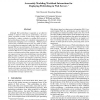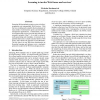ICPP
2003
IEEE
14 years 4 months ago
2003
IEEE
Although Web prefetching is regarded as an effective method to improve client access performance, the associated overhead prevents it from being widely deployed. Specifically, a ...
EUROMICRO
2003
IEEE
14 years 4 months ago
2003
IEEE
The Web services paradigm is expected to transform the Web into a distributed application-to-application network. The Web services landscape is in an evolving state with core spec...
EUROMICRO
2003
IEEE
14 years 4 months ago
2003
IEEE
Recently, several languages for web service composition have emerged (e.g., BPEL4WS and WSCI). The goal of these languages is to glue web services together in a process-oriented w...
COOPIS
2003
IEEE
14 years 4 months ago
2003
IEEE
Emerging Web standards promise a network of heterogeneous yet interoperable Web Services. Web Services would greatly simplify the development of many kinds of information agents a...
CCGRID
2003
IEEE
14 years 4 months ago
2003
IEEE
The most important recent development in Grid systems is the adoption of the Web services model as a basic architecture for Grid services. The result is called the Open Grid Servi...
WWW
2010
ACM
14 years 4 months ago
2010
ACM
This paper addresses the problem of identifying redundant data in large-scale service-oriented information systems. Specifically, the paper puts forward an automated method to pi...
EUROSEC
2010
ACM
14 years 4 months ago
2010
ACM
We present a storage management framework for Web 2.0 services that places users back in control of their data. Current Web services complicate data management due to data lock-in...
WEBI
2004
Springer
14 years 4 months ago
2004
Springer
Business process describes a set of services that span enterprise boundaries and are provided by enterprises that see each other as partners. Web services is widely accepted and a...
TES
2004
Springer
14 years 4 months ago
2004
Springer
Abstract. With the emergence of Web service technologies, it has become possible to use high level megaprogramming models and visual tools to easily build distributed systems using...
SEMWEB
2004
Springer
14 years 4 months ago
2004
Springer
Abstract. We have seen an increasing amount of interest in the application of Semantic Web technologies to Web services. The aim is to support automated discovery and composition o...




